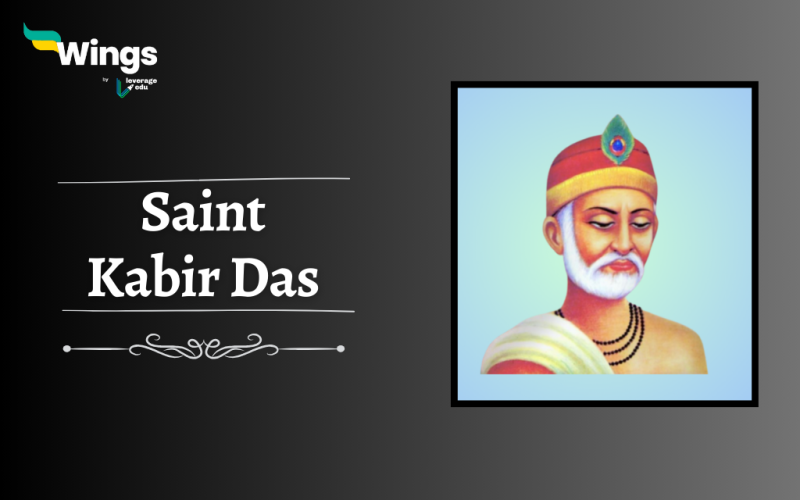Saint Kabir Das was a mystic poet and philosopher and an influential figure in the Bhakti movement of medieval India. His timeless teachings and verses continue to inspire millions of people on the path of divine spiritualism, ethics, belief and poetry to this day. In this article, we will delve into the life, works and contributions of this spiritual luminary and know more about the interesting Kabir das Dohe.
Table of Contents [show]

Who was Kabir Das?
Believed to be born in 1140 in the month of JYestha on Purnima in the 15th century in Varanasi, India, Kabir Das was brought up in a Muslim weaver family. However, his followers believe he appeared in a Lotus on Lahartara pond which was witnessed by Rishi Ashatanand ji. Thus, the birthplace remains a mystery for everyone.
- There are only limited sources to confirm about his early life, but it is suspected that he was found by the Muslim weaver’s family, Niru and Nima.
- He was adopted by the family and was raised there.
- He expanded his knowledge not only in traditional Islamic theology but also in various spiritual traditions and philosophies.
- These diverse influences shaped his unique outlook, blending elements of Hinduism and Islam and culminating in a spiritual inclusivity that transcended religious boundaries.
- Kabir’s early life experiences and exposure to different religious and social contexts laid the foundation for his later works, which emphasized universal spirituality and unity.
Also Read – Goswami Tulsidas: Life, Works and Ramacharitmanas
Philosophy and Poetry by Kabir Das
Guru Ramanand was the teacher of Kabir Das. Das was a revered devotee and an Indian mystic who gave a universal path for religion and combined the ideologies of Hinduism and Islam.
- He believed in and aimed to propagate love, unity and harmony in the people of all castes and religions.
- Both Hindu and Muslim devotees followed his philosophy
- He rejected the idea of idol worship, visiting pilgrimages and baths in holy waters.
- Rejecting the practice of caste system and untouchability, Kabir Das focused more on unity.
- One of his principles is that in every relationship in which we are involved, there is a jivatma and a Paramatma co-existing.
- In Kabir’s Bijak, he mentions about his vision to take the path of spiritualism. He believed that Moksha (liberation) was the way to unite the Jivatma and Paramatma together.
- His belief and trust in both Bhakti and Sufi ideologies further entrusted devotion in both communities of people.
- His devotees follow Kabir Math, which consists of the Kabir Pant community. Kabir Pant community is a religious community and follows the principle of Kabir Das. They describe Kabir as the creator of the sect of Sant Mat.
Also Read – Who was Chaitanya Mahaprabhu?
Works and Contribution of Kabir Das
- Poetic Mastery: Kabir Das composed his insights into short verses, known as “Dohas” or couplets. These dohas were characterized by their simplicity and depth, succinctly conveyed spiritual teachings and social critique.
- He wrote nearly 72 books which were characterised in the form of Doha and Songs. His collection included Kabir Bijak, Holy Agams, Mangal, the Suknidhan, Sabdas, Vasant, Sakhis and Rekhtas.
“Bura Jo Dekhan Main Chala, Bura Naa Milya Koi
(I searched for the wicked, found none
Jo Munn Khoja Apnaa, To Mujhse Bura Naa Koi”
When I searched within myself, I found the wicked one)
Universal Spirituality: Kabir’s teachings emphasized the universality of spirituality which transcended the boundaries of caste, creed, and religion. He advocated for a direct and personal connection with the divine, rather than depending solely on rituals and external practices.
“Maati Kahe Kumhar Se, Tu Kyaa Runde Mohe?
(The clay asks the potter, why do you beat me?
Ek Din Aisa Aayega, Main Rundunga Tohe”
A day will come when I will beat you)
- Social Reformation: Kabir Das fearlessly critiqued social injustices, religious dogmas, and caste-based discrimination prevalent during his time. His verses encouraged people to question the prevalent societal norms and strive for equality and unity.
“Dukh Mein Sumiran Sab Kare, Sukh Mein Kare Na Koye
(Everyone remembers the divine in times of sorrow, but none in happiness
Jo Sukh Mein Sumiran Kare, Toh Dukh Kahe Ko Hoye?”
If one remembers the divine in happiness, why would sorrow exist?)
Legacy and Influence
The saint was a firm believer of practising Ahimsa and participated in the Bhakti and Sufi movements in India through his couplets. Although he was criticized by many, he paid no attention to those and instead showered peace, resilience and love. Kabir’s teachings and philosophy continue to resonate with people across generations, inspiring them to seek a deeper understanding of themselves and the world around them. His poetry forms a significant ideology with countless reinterpretations and renditions by artists and scholars.
In conclusion, Saint Kabir Das with his wisdom and timeless verses, remains not only a spiritual luminary but his teachings on universal spirituality, social reformation, and personal introspection continue to guide seekers on their spiritual journeys. As we delve into Kabir’s poetry and philosophy, we are reminded of the eternal quest for self-realization.
Relevant Blogs
That’s all about Saint Kabir Das! If you want to know more about topics like this, then visit our general knowledge page! Alternatively, you can also read our blog on general knowledge for competitive exams!
 One app for all your study abroad needs
One app for all your study abroad needs















 45,000+ students trusted us with their dreams. Take the first step today!
45,000+ students trusted us with their dreams. Take the first step today!
